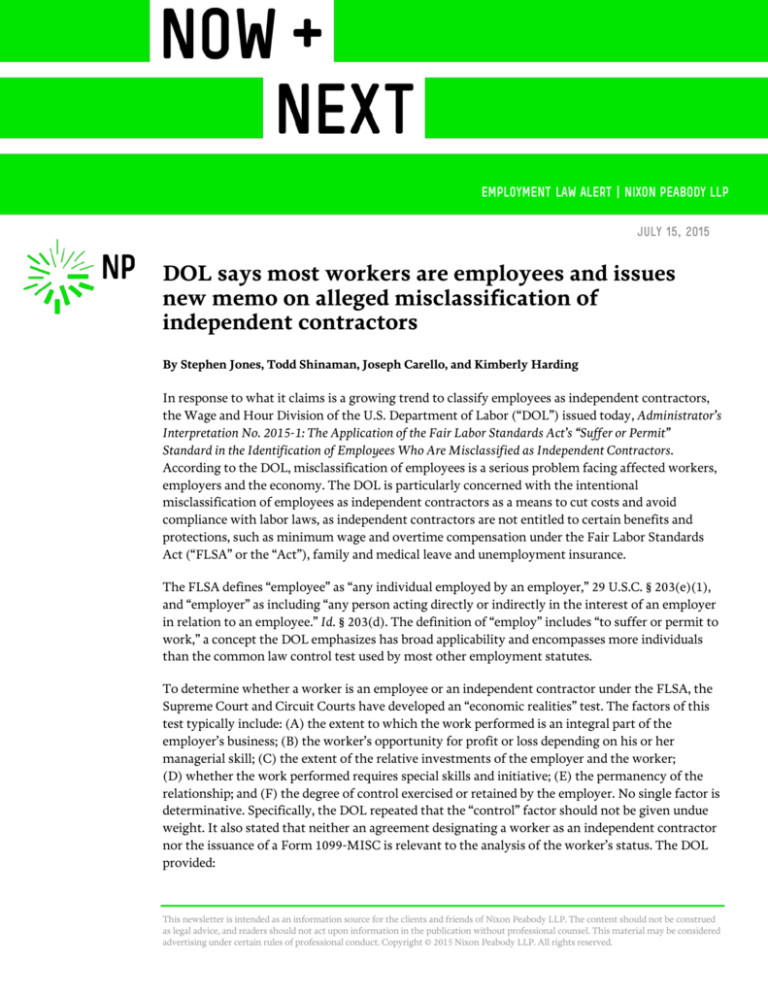
July 15, 2015
DOL says most workers are employees and issues
new memo on alleged misclassification of
independent contractors
By Stephen Jones, Todd Shinaman, Joseph Carello, and Kimberly Harding
In response to what it claims is a growing trend to classify employees as independent contractors,
the Wage and Hour Division of the U.S. Department of Labor (“DOL”) issued today, Administrator’s
Interpretation No. 2015-1: The Application of the Fair Labor Standards Act’s “Suffer or Permit”
Standard in the Identification of Employees Who Are Misclassified as Independent Contractors.
According to the DOL, misclassification of employees is a serious problem facing affected workers,
employers and the economy. The DOL is particularly concerned with the intentional
misclassification of employees as independent contractors as a means to cut costs and avoid
compliance with labor laws, as independent contractors are not entitled to certain benefits and
protections, such as minimum wage and overtime compensation under the Fair Labor Standards
Act (“FLSA” or the “Act”), family and medical leave and unemployment insurance.
The FLSA defines “employee” as “any individual employed by an employer,” 29 U.S.C. § 203(e)(1),
and “employer” as including “any person acting directly or indirectly in the interest of an employer
in relation to an employee.” Id. § 203(d). The definition of “employ” includes “to suffer or permit to
work,” a concept the DOL emphasizes has broad applicability and encompasses more individuals
than the common law control test used by most other employment statutes.
To determine whether a worker is an employee or an independent contractor under the FLSA, the
Supreme Court and Circuit Courts have developed an “economic realities” test. The factors of this
test typically include: (A) the extent to which the work performed is an integral part of the
employer’s business; (B) the worker’s opportunity for profit or loss depending on his or her
managerial skill; (C) the extent of the relative investments of the employer and the worker;
(D) whether the work performed requires special skills and initiative; (E) the permanency of the
relationship; and (F) the degree of control exercised or retained by the employer. No single factor is
determinative. Specifically, the DOL repeated that the “control” factor should not be given undue
weight. It also stated that neither an agreement designating a worker as an independent contractor
nor the issuance of a Form 1099-MISC is relevant to the analysis of the worker’s status. The DOL
provided:
This newsletter is intended as an information source for the clients and friends of Nixon Peabody LLP. The content should not be construed
as legal advice, and readers should not act upon information in the publication without professional counsel. This material may be considered
advertising under certain rules of professional conduct. Copyright © 2015 Nixon Peabody LLP. All rights reserved.
The ultimate inquiry under the FLSA is whether the worker is economically dependent on
the employer or truly in business for him or herself. If the worker is economically
dependent on the employer, then the worker is an employee. If the worker is in business
for him or herself (i.e., economically independent from the employer), then the worker is
an independent contractor.
To aid in this inquiry, the DOL’s guidance discussed each of the factors of the “economic realities”
test. The guidance provides case law and examples and relevant considerations for each factor, and
explains how each factor suggests whether there is an employment relationship. A short summary
for each of these factors is below.
−
Is the work an integral part of the employer’s business?
According to the DOL, if the worker is performing work that is integral to the employer’s
business, the worker is more likely to be an employee. Notably, work can be integral to the
business even if it is performed off-premises, just one component of the business, and/or
performed by hundreds or thousands of other workers.
−
Does the worker’s managerial skill affect the worker’s opportunity for profit or loss?
Here, the DOL evaluates whether the worker’s managerial skill affects his or her
opportunity for profit or loss beyond the current job (such as by leading to additional
business from other parties or by reducing the opportunity for future work). If so, this
factor will weigh in favor of classification as an independent contractor. Notably, the DOL
does not consider the worker’s ability to work more hours or the amount of work available
from the employer.
−
How does the worker’s relative investment compare to the employer’s investment?
Investment by the worker indicates that he or she is an independent business, as
independent contractors typically make investments that support a business as a business
beyond any particular job. However, the worker’s investment “must be significant in nature
and magnitude relative to the employer’s investment in its overall business.” If the worker’s
investment is relatively minor in comparison to the employer’s investment, this suggests
to the DOL that the worker may be an employee as opposed to an independent contractor.
−
Does the work performed require special skill and initiative?
This factor analyzes the worker’s business skills, judgment and initiative to determine
whether the worker is economically dependent. It does not, however, consider the worker’s
technical skills, which the DOL says are not indicative of any independence or business
initiative. Here, the DOL specifically singled out cable installers, carpenters, construction
workers and electricians, and stated that their technical skills were not indicative of any
independence or initiative.
−
Is the relationship between the worker and the employer permanent or indefinite?
Workers engaged on a permanent or indefinite basis are more likely to be classified as
employees, as independent contractors “typically work[] one project for an employer”
rather than continuously or repeatedly for the same employer. The DOL was careful to
point out, however, that a lack of permanence or indefiniteness does not automatically
suggest an independent contractor relationship. The key here is whether the lack of
permanence is due to “operational characteristics intrinsic to the industry.”
−
What is the nature and degree of the employer’s control?
To indicate independent contractor status under this factor, the worker must control
meaningful aspects of the work performed, such that the worker can be viewed as a person
conducting his or her own business. The DOL specified that working from home or offsite
and/or having control over the hours worked are not indicative of independent contractor
status. Rather, the DOL examines “the nature and degree of the employer’s control.”
Given the DOL’s concern about the purported trend of misclassification and its repeated emphasis
on the broad definition of “employee,” it appears that demonstrating that a worker is an
independent contractor will be even more of an uphill battle going forward. Employers should
review their relationships with independent contractors to ensure proper classification, as a finding
of misclassification can result in significant liability for unpaid overtime, unemployment and
workers’ compensation insurance premiums, and statutory and other penalties.
For more information on the content of this alert, please contact your Nixon Peabody attorney or:
— Stephen J. Jones, 585-263-1386, sjones@nixonpeabody.com
— Todd Shinaman, 585-263-1265, tshinaman@nixonpeabody.com
— Joseph Carello, 585-263-1434, jcarello@nixonpeabody.com
— Kimberly Harding, 585-263-1037, kharding@nixonpeabody.com








